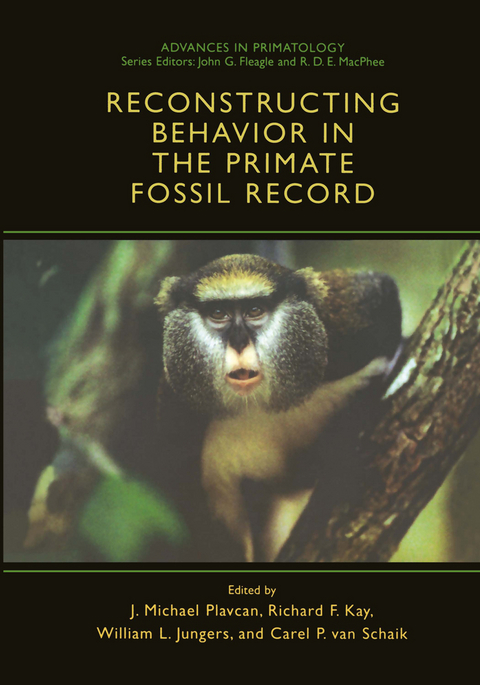
Reconstructing Behavior in the Primate Fossil Record
Springer-Verlag New York Inc.
978-1-4613-5507-6 (ISBN)
This volume brings together a series of papers that address the topic of reconstructing behavior in the primate fossil record. The literature devoted to reconstructing behavior in extinct species is ovelWhelming and very diverse. Sometimes, it seems as though behavioral reconstruction is done as an afterthought in the discussion section of papers, relegated to the status of informed speculation. But recent years have seen an explosion in studies of adaptation, functional anatomy, comparative sociobiology, and development. Powerful new comparative methods are now available on the internet. At the same time, we face a rapidly growing fossil record that offers more and more information on the morphology and paleoenvironments of extinct species. Consequently, inferences of behavior in extinct species have become better grounded in comparative studies of living species and are becoming increas ingly rigorous. We offer here a series of papers that review broad issues related to reconstructing various aspects of behavior from very different types of evi dence. We hope that in so doing, the reader will gain a perspective on the various types of evidence that can be brought to bear on reconstructing behavior, the strengths and weaknesses of different approaches, and, perhaps, new approaches to the topic. We define behavior as broadly as we can including life-history traits, locomotion, diet, and social behavior, giving the authors considerable freedom in choosing what, exactly, they wish to explore.
1 Adaptation and Behavior in the Primate Fossil Record.- Defining Adaptation.- Identifying Adaptations.- How Can Fossil Taxa Be Used to Study Adaptation?.- Summary and.- Conclusions.- References.- 2 Functional Morphology and In Vivo Bone Strain Patterns in the Craniofacial Region of Primates: Beware of Biomechnical Stories about Fossil Bones.- In Vivo Bone Strain Patterns.- Discussion.- Conclusions.- References.- 3 On the Interface between Ontogeny and Function.- Ontogeny as a Criterion of Subtraction.- Biomechanical Scaling and Functional Equivalence.- Heterochrony.- Conclusions.- References.- 4 Dental Ontogeny and Life-History Strategies: The Case of the Giant Extinct Indroids of Madagascar.- Development and the Reconstruction of the Behavior and Life Histories of Extinct Primates: Approaches and Methodologies.- Development and the Reconstruction of Behavior in Extinct Primates: An Example.- Conclusions.- References.- 5 A Comparative Approach to Reconstructing the Socioecology of Extinct Primates.- Methods.- Results.- Worked Examples.- Discussion.- Conclusions.- References.- 6 The Use of Paleocommunity and Taphonomic Studies in Reconstructing Primate Behavior.- The Comparative Method and Actualistic Studies in Paleoecology 220 Fossil Assemblages.- Community Comparisons.- Behavioral Ecology of Primates in Extant and Makapansgat Communities 242 Primate.- Interactions and Behavior Based on Accumulating Agents.- Integration of Community Comparisons.- Evolution, Taphonomy, and Community Paleoecology.- References.- 7 Reconstructing the Diets of Fossil Primates.- Adaptive Signals for Diet in Primates.- Nonadaptive Signals for Diet in Primates.- Discussion.- Summary and Conclusions.- References.- 8 Reconstructing Social Behavior from Dimorphism in the Fossil Record.- Data.- Behavioral Variables.- Relations between Dimorphism and Behavioral Estimates.- Relations between Relative Canine Size and Competition Classifications.- Relations between Dimorphism and Other.- Variables.- Summary and Conclusions.- References.- 9 The Adaptations of Branisella boliviana, the Earliest South American Monkey.- Branisella boliviana, the Earliest-Known Platyrrhine Primate.- Summary and Conclusions.- References.- 10 Ecomorphology and Behavior of Giant Extinct Lemurs from Madagascar.- Body Size and Sexual Dimorphism.- Activity Cycles.- Oral Behaviors.- Positional Behavior.- Summary.- References.- 11 Conclusions: Reconstructing Behavior in the Fossil Record.- The Comparative Approach.- Phylogeny.- Standard Error from Comparative Analyses.- Body Mass and Allometry.- Incomplete Extant Models.- Problems with Defining Behavior.- Multiple Lines of Evidence.- Conclusions.- References.
| Reihe/Serie | Advances in Primatology |
|---|---|
| Zusatzinfo | XIII, 437 p. |
| Verlagsort | New York, NY |
| Sprache | englisch |
| Maße | 178 x 254 mm |
| Themenwelt | Naturwissenschaften ► Biologie ► Evolution |
| Naturwissenschaften ► Geowissenschaften ► Mineralogie / Paläontologie | |
| Sozialwissenschaften ► Ethnologie | |
| Sozialwissenschaften ► Soziologie | |
| ISBN-10 | 1-4613-5507-9 / 1461355079 |
| ISBN-13 | 978-1-4613-5507-6 / 9781461355076 |
| Zustand | Neuware |
| Haben Sie eine Frage zum Produkt? |
aus dem Bereich


